Research on Comprehensive Operation and Maintenance Based on the Fault Diagnosis System of Combine Harvester
Abstract
:1. Introduction
2. Comprehensive Operation and Maintenance Structure Design for Combine Harvester Fault Diagnosis
2.1. Fault Diagnosis Structure of Combine Harvester Operation
2.2. Comprehensive Operation and Maintenance Structure
3. Principle and Realization Process of Fault Diagnosis Algorithm
3.1. SVM Classifier
3.2. Improved PSO Optimization Algorithm
3.2.1. Improvement of Inertia Weight Search Method
3.2.2. Judgment of Premature Convergence
3.3. IPSO-SVM Algorithm Implementation
| Algorithm 1 Steps |
| Step 1: The penalty parameter c and the kernel parameter σ of the SVM are used as the variables to be optimized, and real coding is performed. Step 2: In the d-dimensional parameter space, m particles are randomly initialized, and their positions and velocities are determined, that is, the SVM parameters are determined, and certain input samples are selected to establish the SVM model. Step 3: It is judged whether the termination condition is met. If so, the optimal individual is output and assigned to the penalty parameter c and kernel parameter σ of the SVM. Step 4: If it was not suitable, the SVM was trained to calculate and evaluate the particle fitness value. After the suspension condition is met, the optimal parameters are output and classified. Step 5: If the optimal parameters are not output, the speed and position of the particles will be iteratively searched and updated, the SWM will be retrained, and r the fitness of the particles will be re-evaluated. After the suspension conditions are met, the optimal parameters will be output and classified; otherwise, the velocity and position of particles will be iteratively searched and updated all the time. |
3.4. Comprehensive Operation and Maintenance Architecture
4. Results and Discussion
4.1. Experiment Material
4.2. Data Extraction and Processing
4.2.1. Data Extraction
4.2.2. Data Preprocessing
4.3. Fault Diagnosis Modeling and Verification
4.4. Discussion
5. Conclusions
Author Contributions
Funding
Institutional Review Board Statement
Informed Consent Statement
Data Availability Statement
Acknowledgments
Conflicts of Interest
References
- Luo, Y.; Wei, L.; Xu, L.; Zhang, Q.; Liu, J.; Cai, Q.; Zhang, W. Stereo-vision-based multi-crop harvesting edge detection for precise automatic steering of combine harvester. Biosyst. Eng. 2022, 215, 115–128. [Google Scholar] [CrossRef]
- Li, R.; Cheng, Y.; Xu, J.; Li, Y.; Ding, X.; Zhao, S. Research on On-Line Monitoring System of Hydraulic Actuator of Combine Harvester. Processes 2022, 10, 35. [Google Scholar] [CrossRef]
- Craessaerts, G.; De Baerdemaeker, J.; Saeys, W. Fault diagnostic systems for agricultural machinery. Biosyst. Eng. 2010, 106, 26–36. [Google Scholar] [CrossRef]
- Li, D.; Wang, Y.; Wang, J.; Wang, C.; Sensors, Y.D.J.; Physical, A.A. Recent advances in sensor fault diagnosis: A review. Sens. Actuators A Phys. 2020, 309, 111990. [Google Scholar] [CrossRef]
- Połok, B.; Bilski, P. Intelligent diagnostic system for the rachet mechanism faults detection using acoustic analysis. Measurement 2021, 183, 109637. [Google Scholar] [CrossRef]
- Lin, Y.; Xiao, M.; Liu, H.; Li, Z.; Zhou, S.; Xu, X.; Wang, D. Gear fault diagnosis based on CS-improved variational mode decomposition and probabilistic neural network. Measurement 2022, 192, 110913. [Google Scholar] [CrossRef]
- Xue, L.; Jiang, H.; Zhao, Y.; Wang, J.; Wang, G.; Xiao, M. Fault diagnosis of wet clutch control system of tractor hydrostatic power split continuously variable transmission. Comput. Electron. Agric. 2022, 194, 106778. [Google Scholar] [CrossRef]
- Che, C.; Wang, H.; Ni, X.; Lin, R. Hybrid multimodal fusion with deep learning for rolling bearing fault diagnosis. Measurement 2021, 173, 108655. [Google Scholar] [CrossRef]
- Fu, J.; Ji, C.; Liu, H.; Wang, W.; Zhang, G.; Gao, Y.; Zhou, Y.; Abdeen, M.A. Research Progress and Prospect of Mechanized Harvesting Technology in the First Season of Ratoon Rice. Agriculture 2022, 12, 620. [Google Scholar] [CrossRef]
- Han, F.; Tian, Y.; Zou, Q.; Zhang, X. Research on the Fault Diagnosis of a Polymer Electrolyte Membrane Fuel Cell System. Energies 2020, 13, 2531. [Google Scholar] [CrossRef]
- Garramiola, F.; Poza, J.; Madina, P.; del Olmo, J.; Ugalde, G. A Hybrid Sensor Fault Diagnosis for Maintenance in Railway Traction Drives. Sensors 2020, 20, 962. [Google Scholar] [CrossRef] [Green Version]
- Jin, X.; Chen, K.; Zhao, Y.; Ji, J.; Jing, P. Simulation of hydraulic transplanting robot control system based on fuzzy PID controller. Measurement 2020, 164, 108023. [Google Scholar] [CrossRef]
- Zheng, K.; Jia, G.; Yang, L.; Liu, C. A Cost-Sensitive Diagnosis Method Based on the Operation and Maintenance Data of UAV. Appl. Sci. 2021, 11, 11116. [Google Scholar] [CrossRef]
- Li, Q.; Shang, C.; Li, Z. Communication Fault Maintenance Decision of Information System Based on Inverse Symmetry Algorithm. Symmetry 2020, 12, 126. [Google Scholar] [CrossRef] [Green Version]
- Kok, Z.H.; Mohamed Shariff, A.R.; Alfatni, M.S.M.; Khairunniza-Bejo, S. Support Vector Machine in Precision Agriculture: A review. Comput. Electron. Agric. 2021, 191, 106546. [Google Scholar] [CrossRef]
- Tang, Z.; Zhang, B.; Wang, M.; Zhang, H. Damping behaviour of a prestressed composite beam designed for the thresher of a combine harvester. Biosyst. Eng. 2021, 204, 130–146. [Google Scholar] [CrossRef]
- Sun, D.; Chen, D.; Wang, S.; Wang, X. Development on electrical system performance test stand for combine harvester. IFAC-PapersOnLine 2018, 51, 363–367. [Google Scholar] [CrossRef]
- Yin, Y.; Zhang, Y.; Meng, Z.; Du, C.; Qin, W.; Guo, S. Design and Experiment of Multi-information Collection System for Grain Combine Harvesters. IFAC-PapersOnLine 2018, 51, 855–860. [Google Scholar] [CrossRef]
- Xia, M.; Shao, H.; Williams, D.; Lu, S.; Shu, L.; de Silva, C.W. Intelligent fault diagnosis of machinery using digital twin-assisted deep transfer learning. Reliab. Eng. Syst. Saf. 2021, 215, 107938. [Google Scholar] [CrossRef]
- Chenbo, X.; Guangyou, Y.; Lang, L.; Jing, L.; Xueha, C.; Zhiyan, I. Operation faults monitoring of combine harvester based on SDAE-BP. Trans. Chin. Soc. Agric. Eng. Trans. CSAE 2020, 36, 46–53. [Google Scholar]
- Jing, L.; Guangyou, Y.; Zhiyan, M.; Xuehai, C. Fault diagnosis technology of combine harvester based on random forest. J. Chin. Agric. Mech. 2019, 40, 147–153. [Google Scholar]
- Lili, Y.; Weize, T.; Yuanyuan, X.; Caicong, W. Predicting fuel consumption of grain combine harvesters based on random forest. Trans. Chin. Soc. Agric. Eng. Trans. CSAE 2021, 37, 275–281. [Google Scholar]
- García Nieto, P.J.; García-Gonzalo, E.; Sánchez Lasheras, F.; de Cos Juez, F.J. Hybrid PSO–SVM-based method for forecasting of the remaining useful life for aircraft engines and evaluation of its reliability. Reliab. Eng. Syst. Saf. 2015, 138, 219–231. [Google Scholar] [CrossRef]
- Lv, M.Z.; Liu, S.X.; Su, X.M.; Chen, C.Z. Intelligent Diagnosis of Health Status Based on Isomap and IPSO-SVM. Basic Clin. Pharmacol. Toxicol. 2019, 124, 298–299. [Google Scholar]
- Chen, J.; Wu, P.; Xu, K. Remote Fault Information Acquisition and Diagnosis System of the Combine Harvester Based on LabVIEW. In Proceedings of the 2015 International Conference on Applied Mechanics, Mechatronics and Intelligent Systems (AMMIS2015, Nanjing, China, 19–20 June 2015; pp. 285–292. [Google Scholar]
- Haonan, F.; Sheng, F.; Yonggang, X. Fault diagnosis of rotating machinery based on BN-1DCNN model. J. Vib. Shock 2021, 40, 302–308. [Google Scholar]
- Wen-feng, G.; Hui, C.; Dan-wei, W. Fast fault diagnosis method of marine rotating machinery with multi-sensor monitoring based on improved LSTM-SVM. J. Ship Mech. 2021, 25, 1239–1250. [Google Scholar]
- Zhang, P.; Xu, H.; Hu, Z.; Chen, Y.; Cao, M.; Yu, Z.; Mao, E. Characteristics of Agricultural Dust Emissions from Harvesting Operations: Case Study of a Whole-Feed Peanut Combine. Agriculture 2021, 11, 1068. [Google Scholar] [CrossRef]
- Xue, F.; Zhang, W.; Xue, F.; Li, D.; Xie, S.; Fleischer, J. A novel intelligent fault diagnosis method of rolling bearing based on two-stream feature fusion convolutional neural network. Measurement 2021, 176, 109226. [Google Scholar] [CrossRef]
- Zhou, X.; Xu, X.; Zhang, J.; Wang, L.; Wang, D.; Zhang, P. Fault diagnosis of silage harvester based on a modified random forest. Inf. Process. Agric. 2022, in press. [Google Scholar] [CrossRef]
- Qiu, Z.; Shi, G.; Zhao, B.; Jin, X.; Zhou, L. Combine harvester remote monitoring system based on multi-source information fusion. Comput. Electron. Agric. 2022, 194, 106771. [Google Scholar] [CrossRef]
- Zhang, Q.; Zhang, F. Fault Diagnosis of Press Bearing Based on SDAE-SVM. Digit. Manuf. Sci. 2018, 16, 203–208. [Google Scholar]
- Zhang, H.; Li, Y.N. Research on identification model of element logging shale formation based on IPSO-SVM. Petroleum 2021, in press. [Google Scholar] [CrossRef]
- Xu, H.; Chen, G. An intelligent fault identification method of rolling bearings based on LSSVM optimized by improved PSO. Mech. Syst. Signal Process. 2013, 35, 167–175. [Google Scholar] [CrossRef]
- Wen, Y.; Fashiar Rahman, M.; Xu, H.; Tseng, T.-L.B. Recent advances and trends of predictive maintenance from data-driven machine prognostics perspective. Measurement 2022, 187, 110276. [Google Scholar] [CrossRef]
- Lambinet, F.; Sharif Khodaei, Z. Measurement platform for structural health monitoring application of large scale structures. Measurement 2022, 190, 110675. [Google Scholar] [CrossRef]
- Andria, G.; Attivissimo, F.; Di Nisio, A.; Lanzolla, A.M.L.; Pellegrino, A. Development of an automotive data acquisition platform for analysis of driving behavior. Measurement 2016, 93, 278–287. [Google Scholar] [CrossRef]
- Mourtzis, D.; Angelopoulos, J.; Panopoulos, N. Design and Development of an Edge-Computing Platform Towards 5G Technology Adoption for Improving Equipment Predictive Maintenance. Procedia Comput. Sci. 2022, 200, 611–619. [Google Scholar] [CrossRef]
- Elsisi, M.; Tran, M.Q.; Mahmoud, K.; Mansour, D.-E.A.; Lehtonen, M.; Darwish, M.M.F. Effective IoT-based deep learning platform for online fault diagnosis of power transformers against cyberattacks and data uncertainties. Measurement 2022, 190, 110686. [Google Scholar] [CrossRef]
- Xiao-lu, X.; Tao, W.; Hong, G. Fault diagnosis of metro vehicle traction control unit based on IPSO-SVM. J. Dalian Univ. Technol. 2015, 55, 67–72. [Google Scholar]
- Min-jie, W.; Hong, A. Fault Diagnosis of Cement Calcination System Based on SVM Optimized by IPSO. Control Instrum. Chem. Ind. 2019, 46, 983–987, 1006. [Google Scholar]
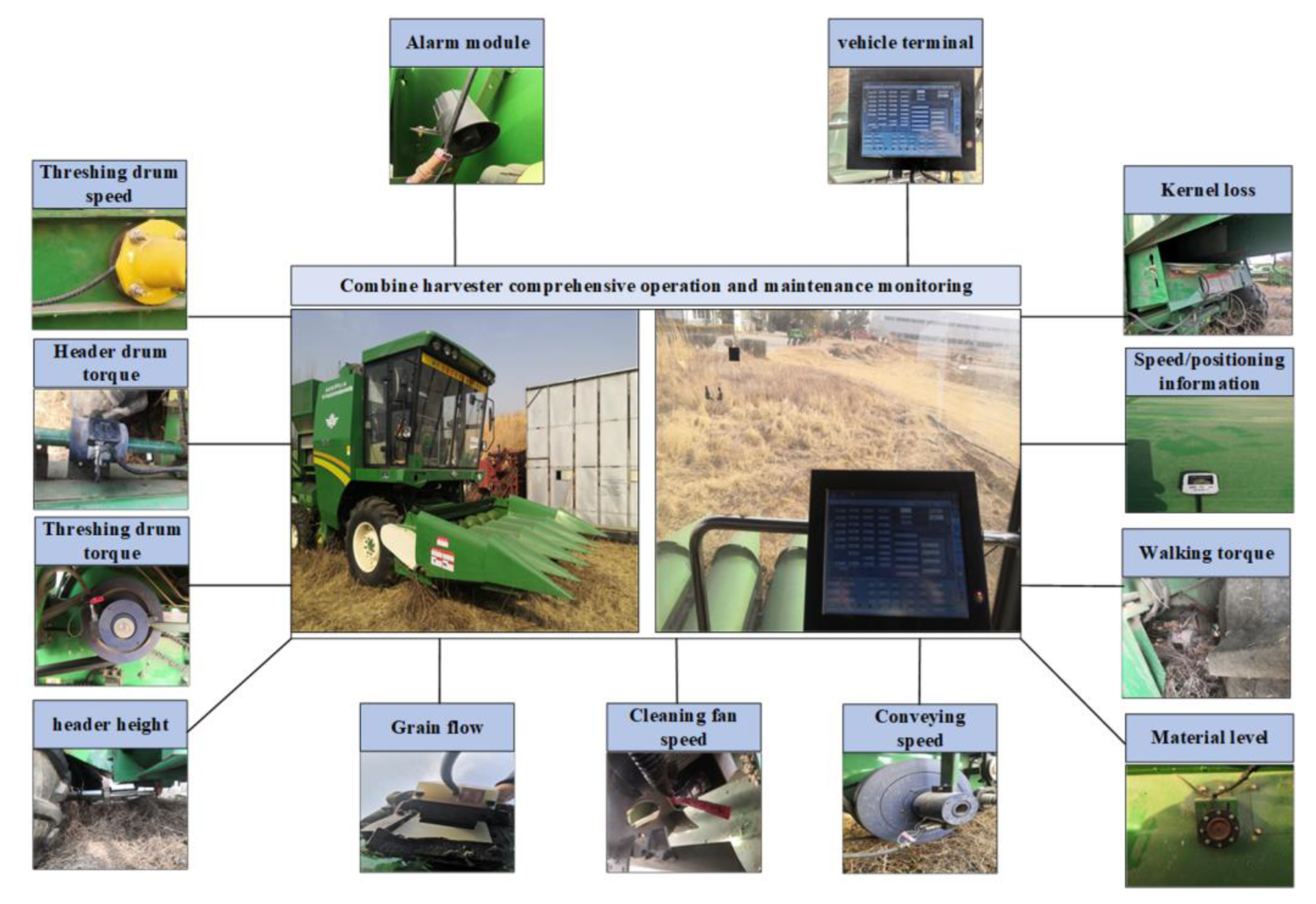
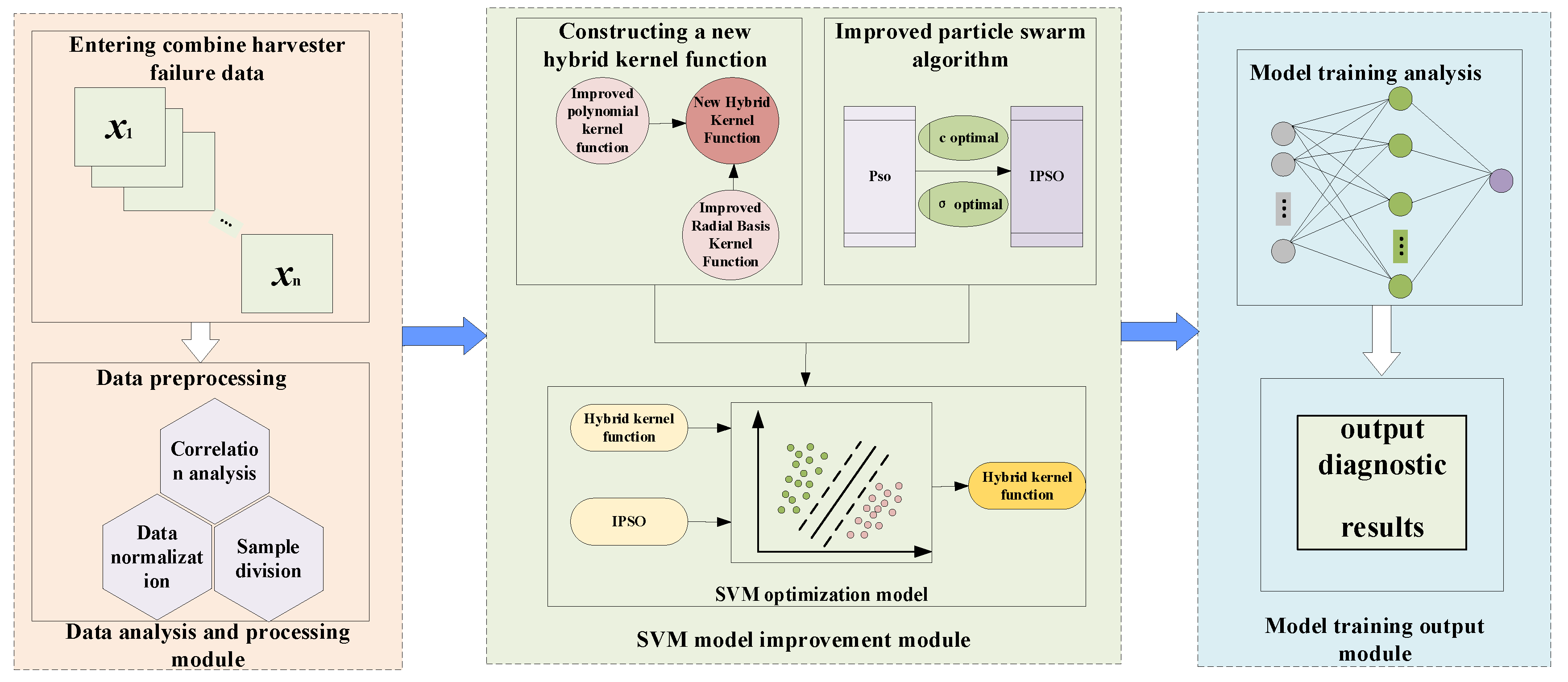
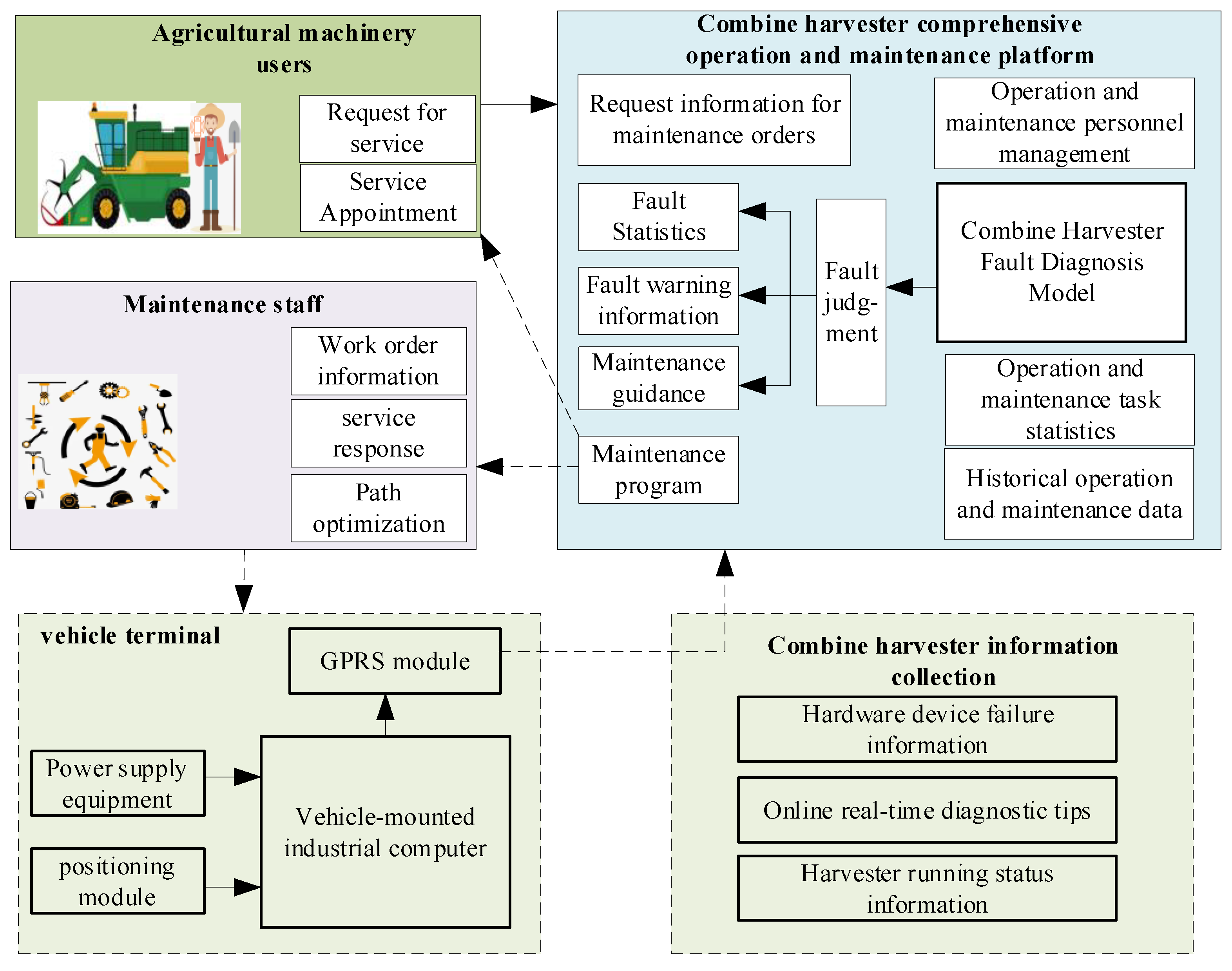
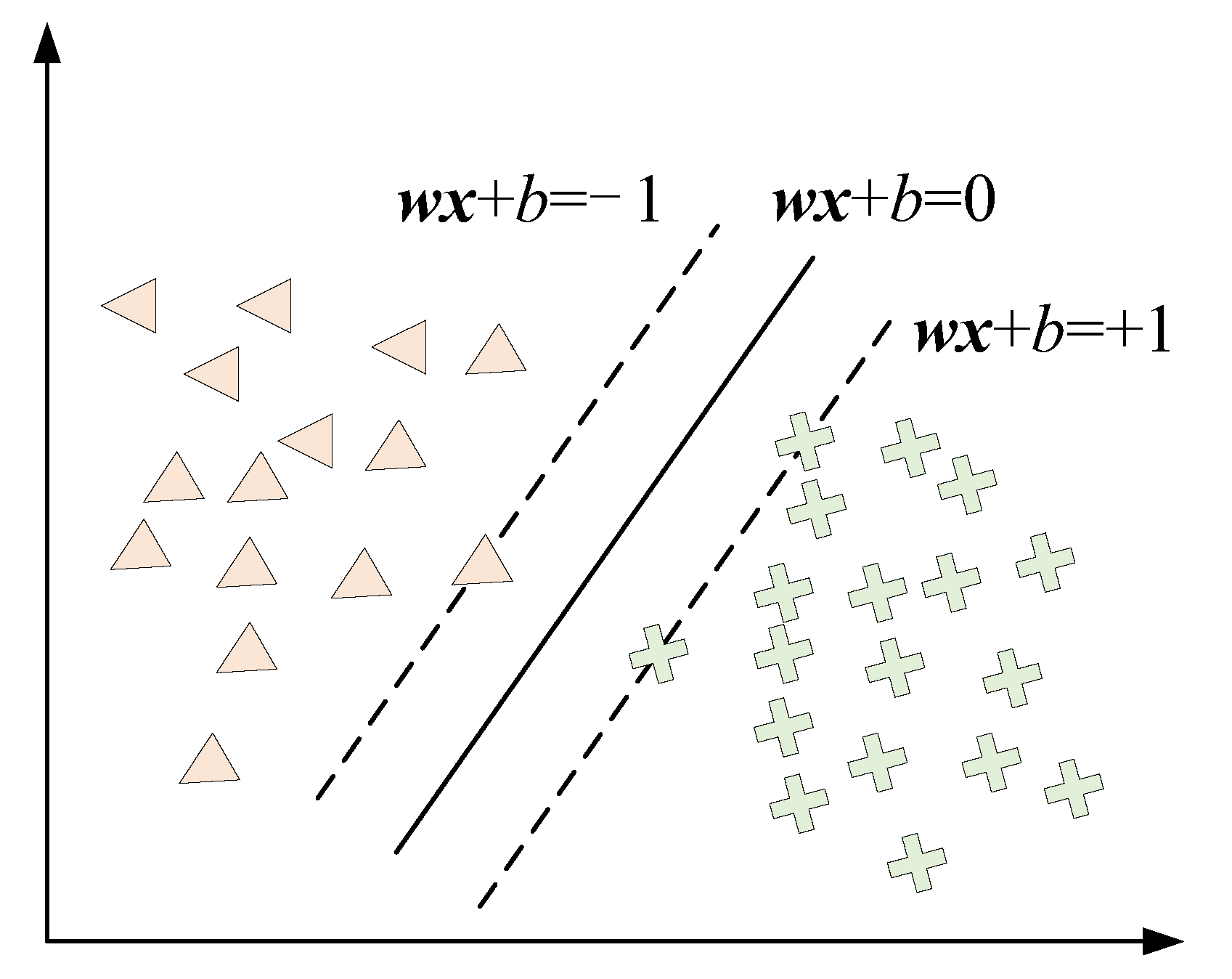
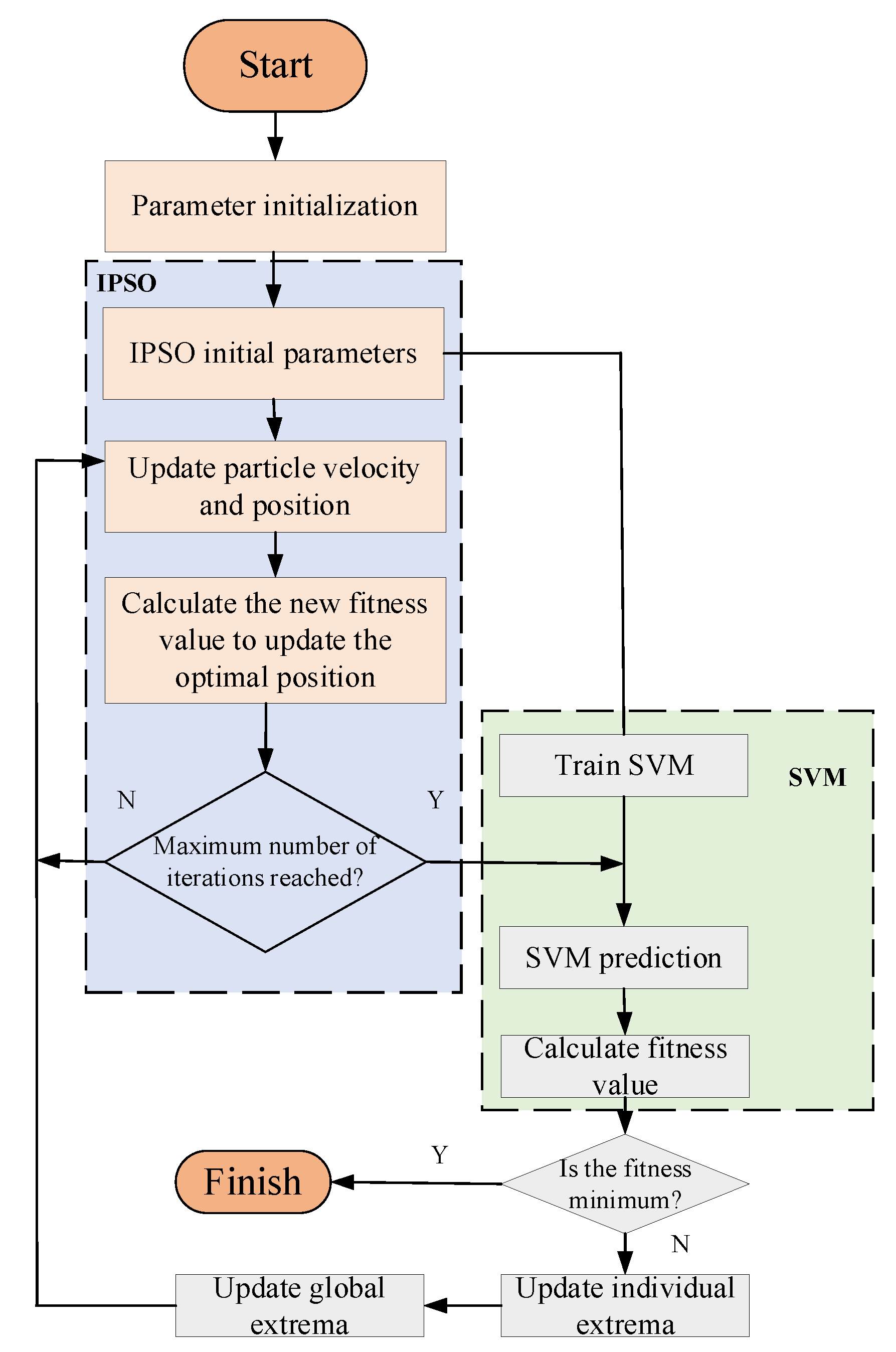
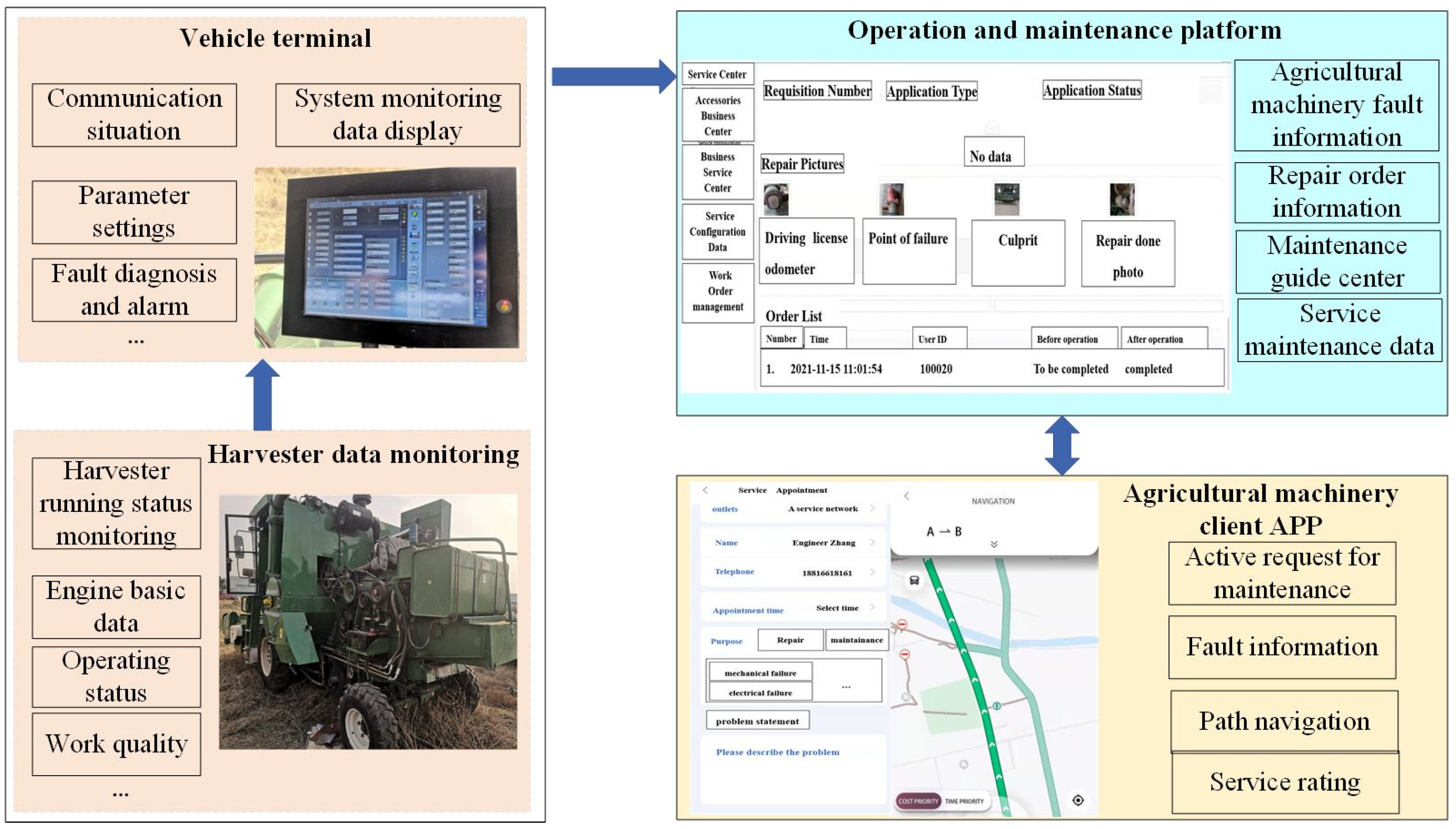
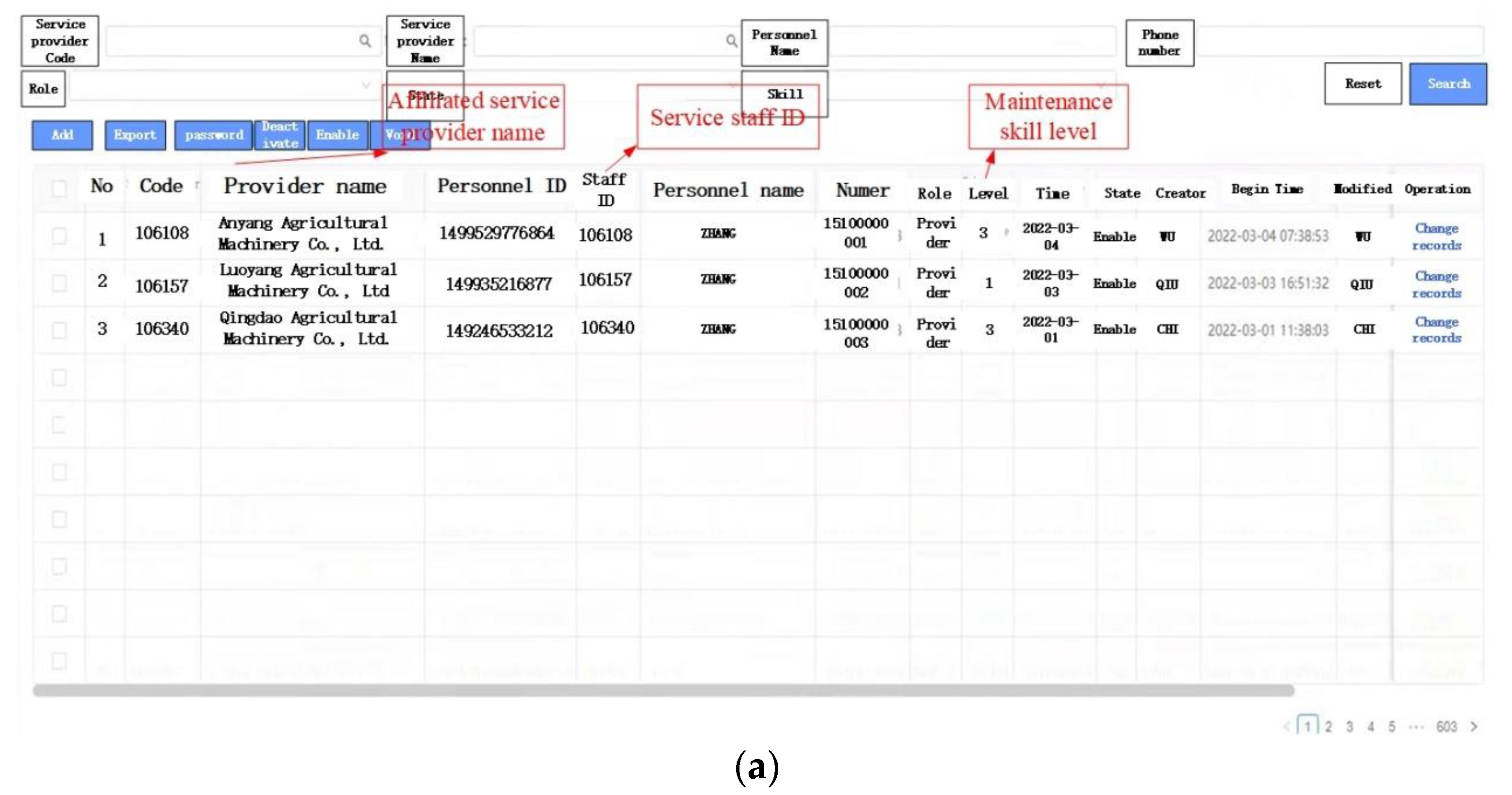
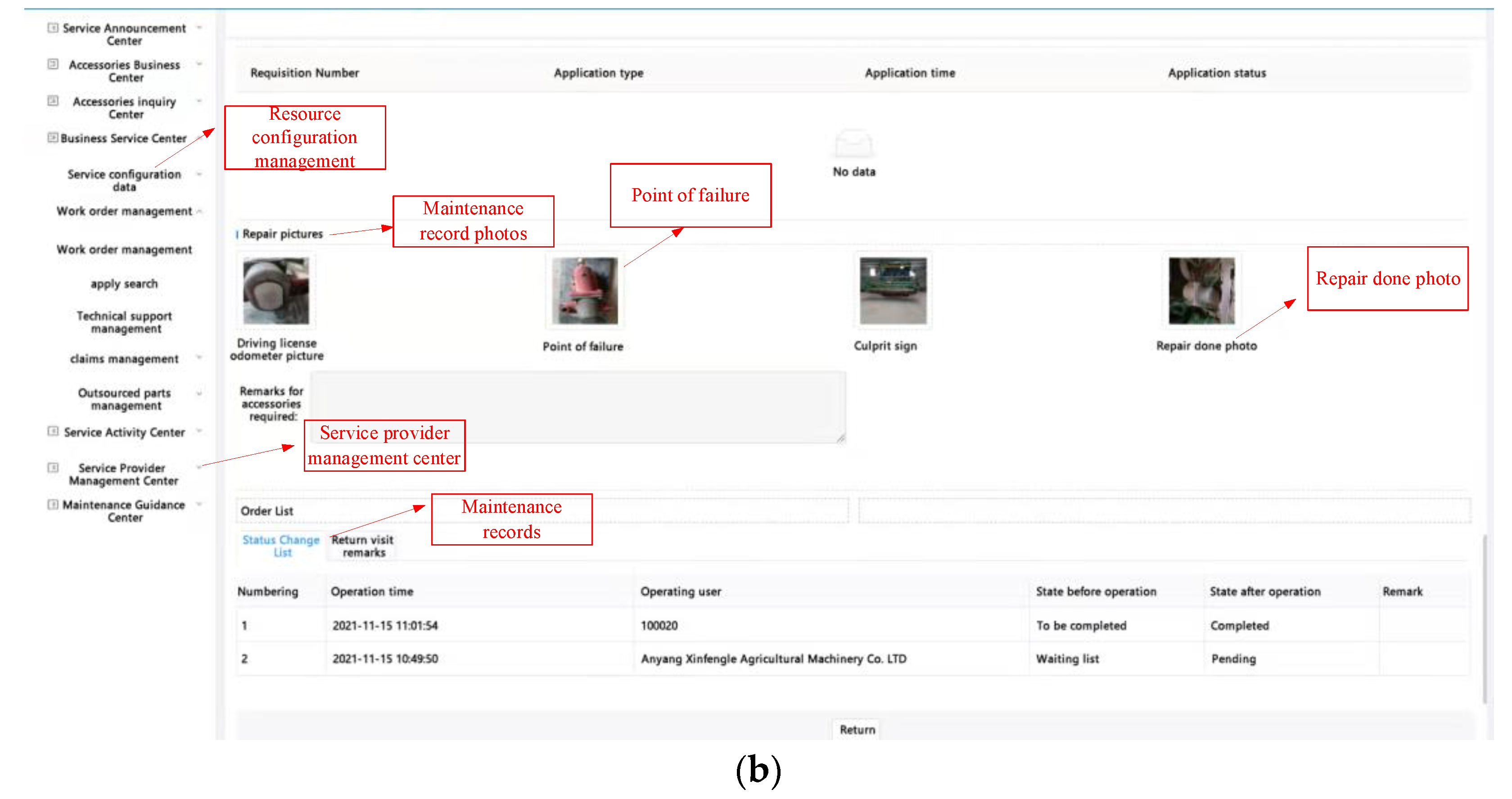
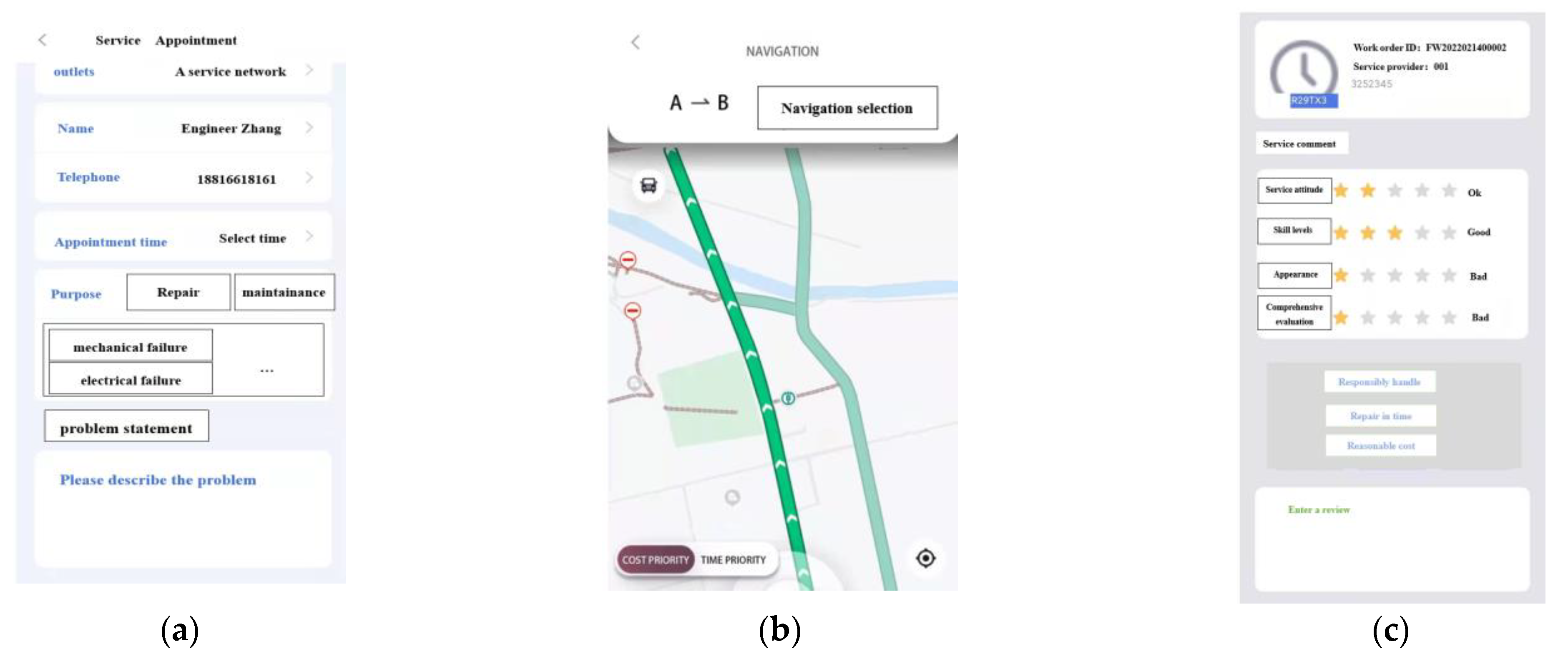
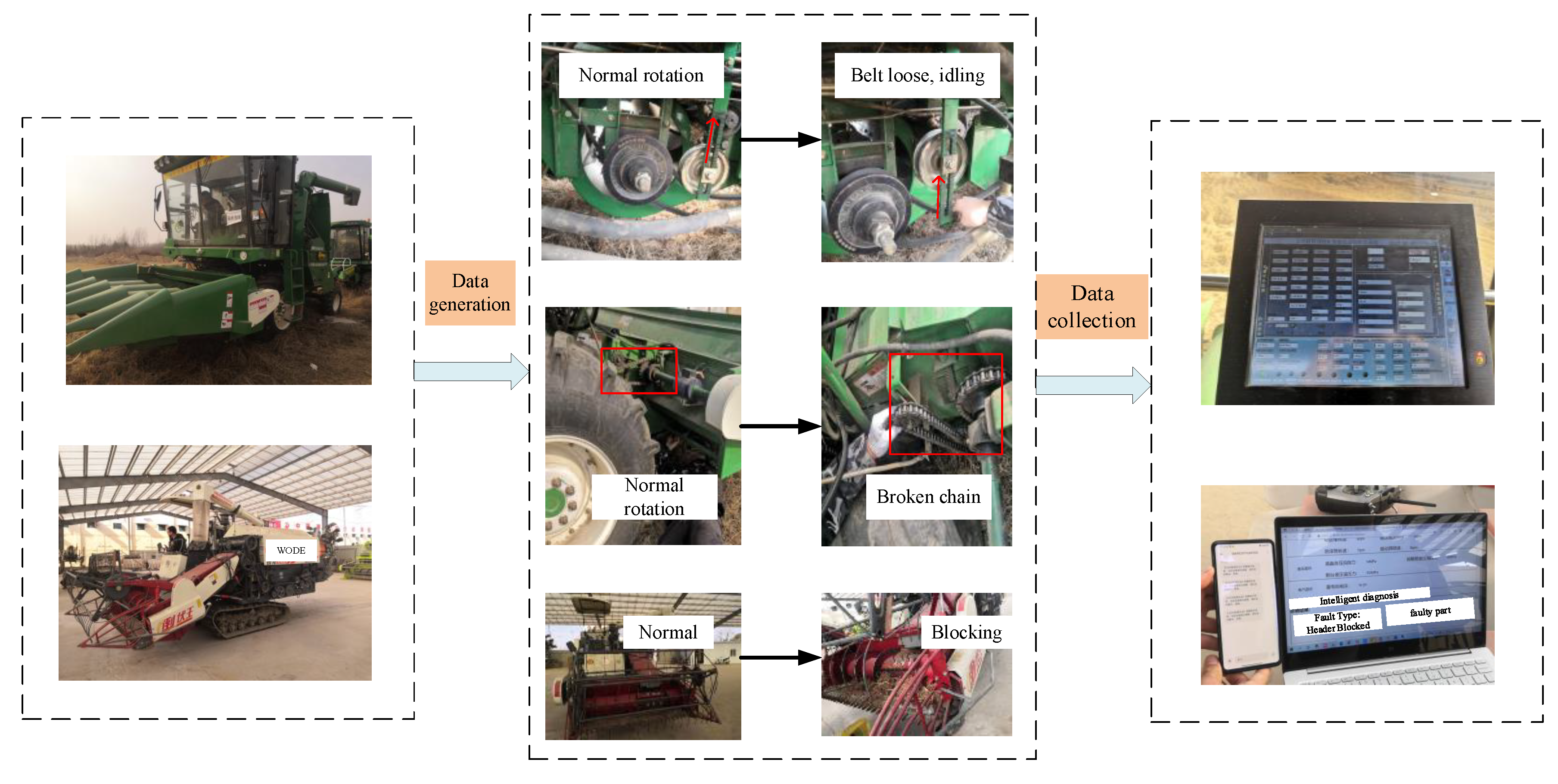
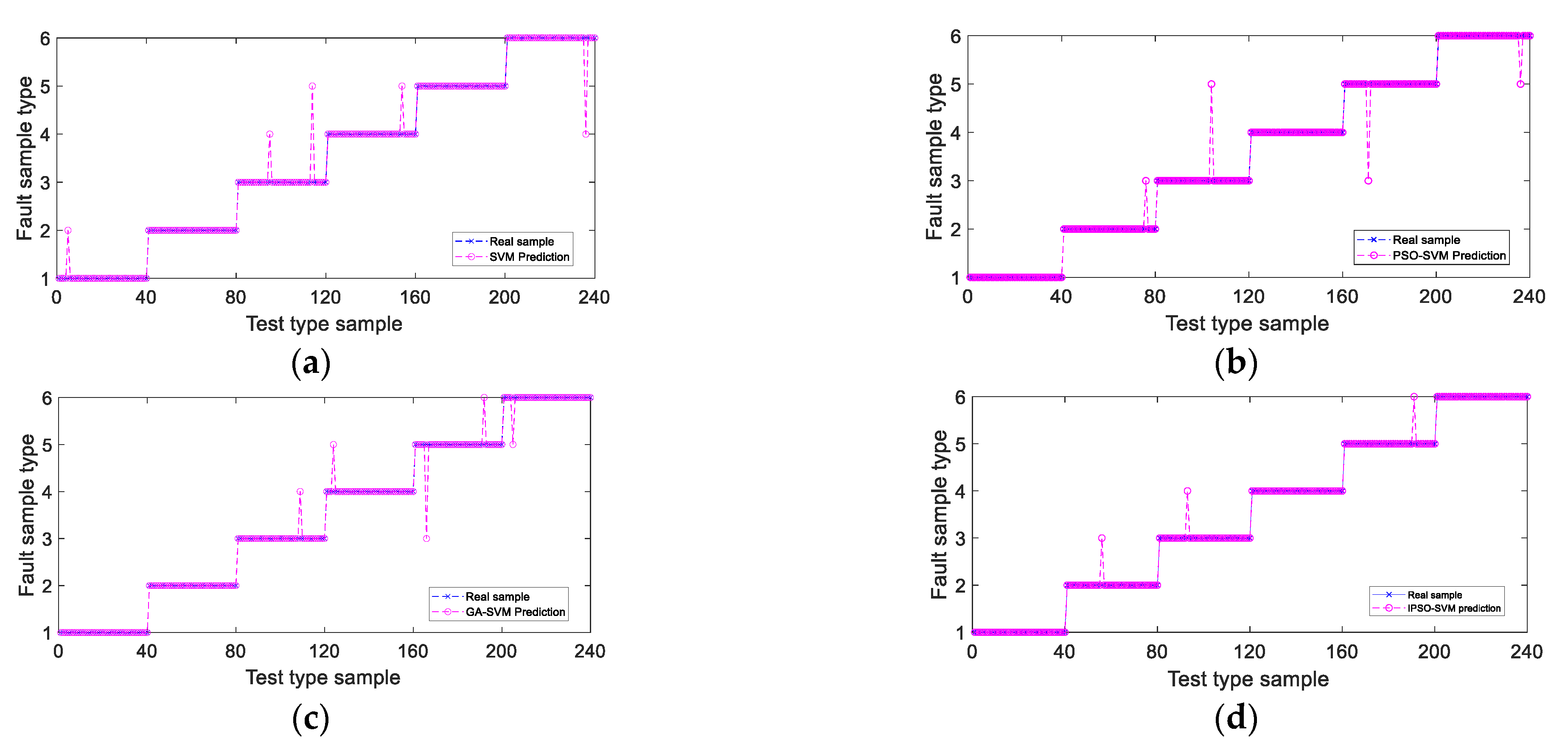
| Number | Feeding Auger Speed/(r·min−1) | Fan Speed/(r·min−1) | Conveyor Chain Rake Speed/(r·min−1) | Threshing Drum Speed/(r·min−1) | Stepper Speed/(r·min−1) |
|---|---|---|---|---|---|
| 1 | 247.69 | 1533.45 | 559.72 | 738.91 | 173.68 |
| 2 | 234.59 | 1485.25 | 581.22 | 758.33 | 174.18 |
| 3 | 259.38 | 1496.25 | 545.33 | 749.35 | 174.68 |
| 4 | 232.65 | 1280.33 | 521.45 | 759.33 | 175.18 |
| 5 | 241.34 | 1652.15 | 529.12 | 744.52 | 175.68 |
| 6 | 238.73 | 1435.95 | 535.18 | 759.74 | 171.18 |
| 7 | 237.24 | 1399.16 | 536.65 | 724.96 | 176.68 |
| 8 | 141.19 | 1533.45 | 159.71 | 146.18 | 48.24 |
| 9 | 85.81 | 1533.45 | 66.12 | 0 | 13.28 |
| 10 | 41.22 | 1533.45 | 0 | 0 | 23.56 |
| 11 | 231.18 | 1507.34 | 533.18 | 755.84 | 176.15 |
| 12 | 239.94 | 1518.65 | 545.18 | 721.06 | 176.61 |
| 13 | 258.49 | 1529.54 | 531.65 | 746.44 | 177.07 |
| 14 | 243.24 | 1540.13 | 554.98 | 751.54 | 177.53 |
| 15 | 235.57 | 1551.64 | 523.31 | 748.22 | 177.99 |
| 16 | 230.34 | 1562.36 | 535.18 | 725.24 | 178.45 |
| 17 | 41.22 | 1521.45 | 0 | 0 | 23.85 |
| 18 | 235.81 | 1584.65 | 527.98 | 732.38 | 179.37 |
| 19 | 234.34 | 1495.28 | 571.68 | 747.34 | 179.83 |
| 20 | 232.82 | 1606.54 | 541.14 | 742.82 | 180.29 |
| Data | Total Data | Normal | Feeding Auger Clogged | Fan Failure | Conveyor Chain Rake Clogged | Threshing Drum Clogged | The Scraper Belt Is Loose |
|---|---|---|---|---|---|---|---|
| Training set | 2000 | 1350 | 140 | 127 | 185 | 140 | 247 |
| Test set | 700 | 300 | 38 | 36 | 44 | 40 | 53 |
| Fault Location | Fault Type | Changes |
|---|---|---|
| Feed the auger | Broken auger drive chain | Header auger does not turn |
| Threshing drum | Threshing drum clogged | Unable to thresh off the drum |
| stepper | The stepper is clogged | The stepper does not move |
| Conveyor chain rake | Conveyor chain rake drive chain broken | Conveyor is blocked or does not turn |
| Fan | Loose and broken fan pulley belt | Fan does not turn |
| Operation Faults | Number of Samples | Number of Correct Classification | Number of Error Classification | Accuracy Rate/% |
|---|---|---|---|---|
| Normal | 364 | 364 | 0 | 100 |
| Feeding auger clogged | 55 | 53 | 0 | 96.36 |
| Fan failure | 37 | 36 | 1 | 97.30 |
| Conveyor chain rake clogged | 25 | 25 | 0 | 100 |
| Threshing drum clogged | 17 | 16 | 1 | 94.11 |
| Scraper belt is loose | 72 | 72 | 0 | 100 |
| Average recognition accuracy | 97.96 | |||
| Method | Optimized Model Parameters | Classification Time/s | Normal Sample Accuracy/% | Fault Sample Accuracy/% | Average Accuracy/% | |
|---|---|---|---|---|---|---|
| Penalty Factor c | Kernel Function σ | |||||
| IPSO-SVM | 3.281 | 0.407 | 7.9524 | 97.99 | 97.91 | 97.96 |
| PSO-SVM | 3.674 | 0.571 | 100.0000 | 90.57 | 94.55 | 92.56 |
| GA-SVM | 2.455 | 4.523 | 9.8772 | 89.93 | 88.95 | 89.44 |
| SVM | 21.2399 | 5.158 | 8.2145 | 86.67 | 88.35 | 87.51 |
Publisher’s Note: MDPI stays neutral with regard to jurisdictional claims in published maps and institutional affiliations. |
© 2022 by the authors. Licensee MDPI, Basel, Switzerland. This article is an open access article distributed under the terms and conditions of the Creative Commons Attribution (CC BY) license (https://creativecommons.org/licenses/by/4.0/).
Share and Cite
Zhang, W.; Zhao, B.; Zhou, L.; Wang, J.; Niu, K.; Wang, F.; Wang, R. Research on Comprehensive Operation and Maintenance Based on the Fault Diagnosis System of Combine Harvester. Agriculture 2022, 12, 893. https://doi.org/10.3390/agriculture12060893
Zhang W, Zhao B, Zhou L, Wang J, Niu K, Wang F, Wang R. Research on Comprehensive Operation and Maintenance Based on the Fault Diagnosis System of Combine Harvester. Agriculture. 2022; 12(6):893. https://doi.org/10.3390/agriculture12060893
Chicago/Turabian StyleZhang, Weipeng, Bo Zhao, Liming Zhou, Jizhong Wang, Kang Niu, Fengzhu Wang, and Ruixue Wang. 2022. "Research on Comprehensive Operation and Maintenance Based on the Fault Diagnosis System of Combine Harvester" Agriculture 12, no. 6: 893. https://doi.org/10.3390/agriculture12060893
APA StyleZhang, W., Zhao, B., Zhou, L., Wang, J., Niu, K., Wang, F., & Wang, R. (2022). Research on Comprehensive Operation and Maintenance Based on the Fault Diagnosis System of Combine Harvester. Agriculture, 12(6), 893. https://doi.org/10.3390/agriculture12060893





